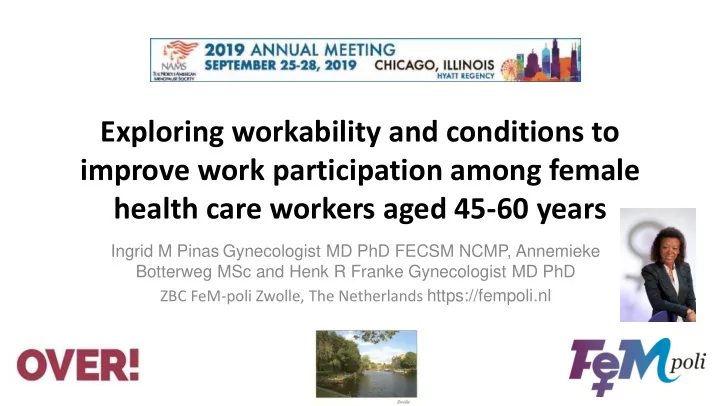

Exploring workability and conditions to improve work participation among female health care workers aged 45-60 years Ingrid M Pinas Gynecologist MD PhD FECSM NCMP, Annemieke Botterweg MSc and Henk R Franke Gynecologist MD PhD ZBC FeM-poli Zwolle, The Netherlands https://fempoli.nl
Financial disclosure slide • I have no financial relationships to disclose.
Introduction • 62% of Dutch women have paid jobs • 84% of our healthcare workers are female and • 23% are 50+ • Despite economic need to continue working at older • Increasing age-related sickness age, ability is compromised absence% and duration of absence among Dutch female employees UWV 2018; CBS 2014
Absenteeism: does menopause play a role • Significant negative association exists between menopause symptoms and workability • A 33.8% risk of sickness absence related to mild menopause symptoms among 208 Dutch health care workers aged 40 to 60 • Discussing menopause in the workplace seems a taboo and specific needs of women concerned are mostly unknown Geukes M 2012; Gartoulla P 2016; Olajubu AO 2017; Beck V 2019
Study: self report questionnaires Aim : • Greene Climacteric Scale (GCS) • To assess menopause symptoms and • Work Ability Index (WAI) associations with workability of • Demographics, lifestyle, medical women aged 45-60 in a larger sample • history, education to explore conditions to sustain participation in the workforce • Added open questions: a. What should your employer do Method : to improve your workability? • 590 female employees aged 45-60 years from health care facilities b. What can you do to improve completed structured questionnaires your workability? and answered added open questions
Workability Index (WAI) • Predicts risk of future impairment and duration of sickness absence within next 2 yrs • Balances a persons current resources, disease diagnoses, past history of absence, estimated impairment, own prognosis of work ability against work demands • Score runs from 7 to 49 points: < 37 points indicate “poor” work ability; ≥ 37 points indicate “good/excellent” work ability Ilmarinen J et al 2005
Results • Total GCS and subscale parameters Average (SD i.a.) scores were significantly Age yrs 52.8 ( 4.49) negatively associated BMI kg/m² 26.0 (7.06) with WAI scores: Pearson % smoking 15 r -0.568 ( p <.001) for % excercise>twice 60.5 WAI/ total GSC weekly • Depressive symptoms GCS score 10.9 (6.57) were most predictive for WAI score 39 ( 5.24) risk of absence: Pearson r - 0.554 ( p <.001). % Poor WAI score 27 (<37)
Top 5 Participants needs Expectations from employers Individual needs • reduce job demands • optimize lifestyle • improve work environment • discuss boundaries • quality of communication • future choices and productivity • leadership and personal • more assertiveness and help attention seeking behaviour for complaints • more flexibility of work • personal development and schedules education
Follow up on age related absenteeism% • Preliminary data of the Age related Absenteeism% before and after GCS and Workability first 8 months of 2018 Questionnaire study vs 2019 show drop in 12 10 absenteeism% of 8 6 1.89% 4 • We do not know yet if 2 0 there is a cause-effect 45-50 50-55 55-60 60-65 Average National absent% absent % 2018 absent % 2019 association
Discussion • Our study confirmed a 27% menopause related risk of sickness absenteeism among female health care workers and added their individual needs and expectations from employers • Potential barriers to discuss menopause may have been lifted • Is there a window of opportunity to improve care and work participation of Dutch women transitioning in menopause? • 17 years after WHI fear and misunderstandings kept us away from treating bothersome menopause symptoms
Post WHI Hormone Therapy users (%) in Europe ♀ ♀ 45-69yrs WHI (Women’s Health Initiative) Ameye L et al 2014
Menopause care: Past - Present WHI • BC scare 2002 • No need GP 2012 to treat or refer • Health issues Present • Productivity • Life expectancy
Conclusion • A 27% risk of menopause associated absence was found, especially from depressive symptoms, in Dutch health care workers aged 45-60 • Suggestions for improvement related to work load and environment, communication, autonomy; individual needs were optimizing lifestyle, assertiveness and personal development • Preliminary follow up data suggesting a drop in absenteeism% of 1.89% since study was initiated need further confirmation • We hypothesize that increased awareness and discussion of menopause in the workplace may lead to more adequate help seeking behaviour and less absenteeism
Recommend
More recommend